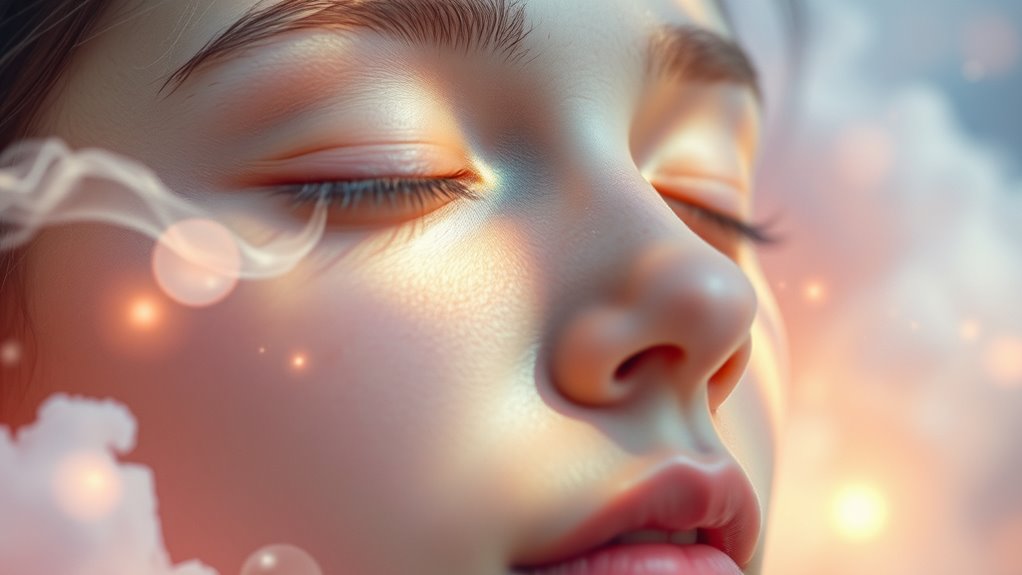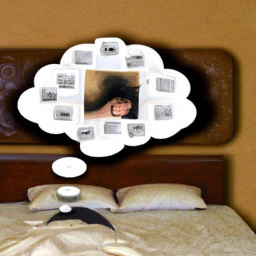Dreams feel so real because your brain activates the same perception and sensory areas it uses when you’re awake, especially during REM sleep. This heightened activity creates vivid images, sounds, and sensations that can be indistinguishable from reality. As your brain immerses itself in this internal simulation, it blurs the line between dreaming and waking life. To discover more about what makes these dreams so convincing, keep exploring how your mind creates these immersive experiences.
Key Takeaways
- During REM sleep, the brain activates perception and self-awareness areas, creating vivid, lifelike mental imagery.
- Increased neural activity in sensory regions enhances colors, sounds, and tactile sensations in dreams.
- Lucid dreaming heightens awareness, allowing greater control and more intense sensory experiences.
- The brain’s internal simulation of reality during vivid dreams makes them feel indistinguishable from waking life.
- The vividness of dreams can linger in memory, reinforcing their convincing and authentic feeling.

Have you ever woken up feeling convinced that a dream was real, only to realize it was just a vivid illusion? That sensation is both fascinating and perplexing, highlighting how dreams can blur the line between imagination and reality. Some dreams feel so convincing because of a phenomenon called lucid dreaming, where you become aware that you’re dreaming while still inside the dream. When you’re lucid, you often gain a surprising level of control, which can amplify the sensory vividness—making the sights, sounds, and feelings seem incredibly real. This heightened sensory experience is what makes certain dreams feel indistinguishable from waking life.
Lucid dreaming enhances sensory vividness, making dreams feel so real you question reality upon waking.
Lucid dreaming taps into your awareness within the dream state, and as you become conscious of dreaming, your brain ramps up activity in areas responsible for perception and self-awareness. This increased activity results in a more intense sensory experience. You might vividly see colors, hear sounds with clarity, or even feel textures and temperatures as if they were happening in real life. The sensation becomes so immersive that your brain creates a convincing simulation, fooling your consciousness into believing it’s real. This is why lucid dreams often feel so genuine—they engage the same neural pathways used when you experience the world while awake.
The vividness of these dreams isn’t accidental. It’s driven by your brain’s ability to generate detailed mental imagery, heightened during REM sleep when most dreaming occurs. During this phase, your brain’s visual and sensory processing centers are highly active, which explains why dreams can appear so detailed and lifelike. Some researchers suggest that this sensory vividness is a way for your brain to process emotions, memories, or unresolved conflicts in a safe, internal environment. When you’re lucid, you might also notice that your mind consciously amplifies these details, making the dream feel even more real.
What’s remarkable is that this vividness can sometimes be so intense that it leaves you questioning reality even after waking. You might recall the sharpness of a dream’s colors or the warmth of a familiar voice, making it difficult to distinguish between dream and waking life at first. The reason some dreams feel so authentic lies in this incredible capacity of your brain to simulate reality through sensory vividness and conscious awareness. That’s why, even after you wake up, the memory of a particularly vivid dream can linger, blurring the boundaries of what you thought was real and what was just a product of your mind during sleep. Additionally, the high activity in perception-related brain areas during REM sleep contributes significantly to this vividness, further blurring the lines between dream and reality.
Frequently Asked Questions
Can Dreams Predict Future Events?
Dreams can sometimes seem to predict future events, but it’s usually your subconscious mind working through feelings and symbols. You might notice dream symbolism that reflects your fears, hopes, or desires, which can hint at what’s ahead. While these dreams aren’t literal predictions, they help you understand your inner thoughts. Pay attention to recurring themes, as they reveal insights from your subconscious mind about potential future situations.
Why Do Some Dreams Cause Physical Sensations?
In a future where dreams seem almost tangible, you experience physical sensations due to sensory integration and neural activation. Your brain mimics real-life stimuli, activating sensory pathways that cause feelings like touch, pain, or temperature changes. This process involves complex neural signals that create a realistic experience, making you feel as if you’re genuinely experiencing the events. These sensations are a proof to how vividly your brain can simulate reality during sleep.
How Do Emotions Influence Dream Realism?
Your emotions greatly influence how real your dreams feel because emotional intensity heightens your subconscious effects. When you experience strong feelings like fear, joy, or anger, your brain creates more vivid, immersive scenarios to process these emotions. This heightened emotional state makes your dreams seem more authentic, blurring the line between reality and imagination. So, the deeper your emotional response, the more realistic your dream experiences tend to be.
Can Lucid Dreaming Make Dreams Feel More Real?
Ironically, lucid dreaming can make dreams feel more real because it boosts your dream awareness and sensory clarity. When you’re conscious you’re dreaming, you notice details more vividly, making the experience immersive. This heightened awareness sharpens your senses, blurring the line between dream and reality. So, instead of drifting aimlessly, you actively shape your dream, intensifying its realism and making it feel almost indistinguishable from waking life.
Do Recurring Dreams Feel More Vivid Than Others?
Recurring dreams often feel more vivid because of their heightened dream intensity and emotional vividness. When a dream repeats, your subconscious becomes more familiar with its themes, making the images and feelings more intense. You might notice stronger emotions or sharper details, which amplifies the overall vividness. This familiarity deepens the emotional impact, making the recurring dream seem even more real and memorable compared to one-time dreams.
Conclusion
So, next time you wake up puzzled by a dream that felt more real than your mornings, remember—your mind’s clever trickery has blurred the lines between waking and sleeping. Ironically, it’s this very illusion that keeps you questioning what’s truly real. In a way, those vivid dreams remind you that reality itself might just be another sort of dream, crafted by your brain’s mysterious, fascinating design. Sleep tight, and enjoy the illusion.









